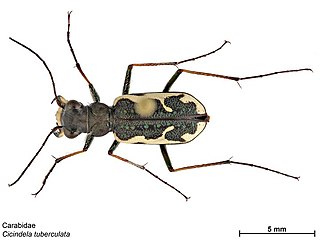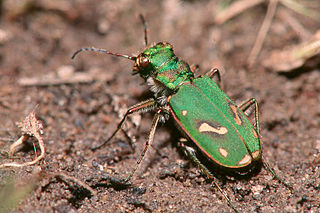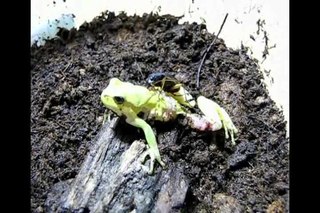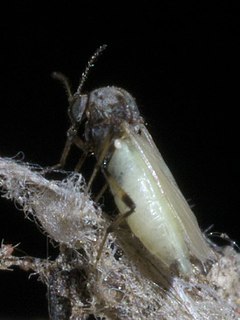Related Research Articles

Salamanders are a group of amphibians typically characterized by a lizard-like appearance, with slender bodies, blunt snouts, short limbs projecting at right angles to the body, and the presence of a tail in both larvae and adults. All 10 present-day salamander families are grouped together under the order Urodela. Salamander diversity is highest in the Northern Hemisphere and most species are found in the Holarctic realm, with some species present in the Neotropical realm.

The Asilidae are the robber fly family, also called assassin flies. They are powerfully built, bristly flies with a short, stout proboscis enclosing the sharp, sucking hypopharynx. The name "robber flies" reflects their notoriously aggressive predatory habits; they feed mainly or exclusively on other insects and as a rule they wait in ambush and catch their prey in flight.

Insect mandibles are a pair of appendages near the insect’s mouth, and the most anterior of the three pairs of oral appendages. Their function is typically to grasp, crush, or cut the insect’s food, or to defend against predators or rivals. Insect mandibles, which appear to be evolutionarily derived from legs, move in the horizontal plane unlike those of vertebrates, which appear to be derived from gill arches and move vertically.

Cleridae are a family of beetles of the superfamily Cleroidea. They are commonly known as checkered beetles. The family Cleridae has a worldwide distribution, and a variety of habitats and feeding preferences.

The Mexican bean beetle is a species of lady beetle that can be an agricultural pest. It is one of the few North American lady beetles that feed on plants rather than other insects. It is found throughout Mexico and the eastern United States, and is abundant in the wetter and more heavily irrigated areas west of the Rocky Mountains. It does not tolerate extremely dry areas.

Carabus auratus, the golden ground beetle, is a member of the family Carabidae, or ground beetles, native to central and western parts of Europe.

Cotinis nitida, commonly known as the green June beetle, June bug or June beetle, is a beetle of the family Scarabaeidae. It is found in the eastern United States and Canada, where it is most abundant in the South. It is sometimes confused with the related southwestern species figeater beetle Cotinis mutabilis, which is less destructive.

Chrysomya is an Old World blow fly genus of the family Calliphoridae. The genus Chrysomya contains a number of species including Chrysomya rufifacies and Chrysomya megacephala. The term “Old World blow fly” is a derivative of both the associated family, Calliphoridae, and the belief that the genus Chrysomya originated in Asia and migrated to North America only relatively recently. Chrysomya’s primary importance to the field of medico-criminal forensic entomology is due to the genus’ reliable life cycle, allowing investigators to accurately develop a postmortem interval. Chrysomya adults are typically metallic colored with thick setae on the meron and plumose arista. The name comes from the word chrysos, meaning “golden” in reference to the metallic sheen of the genus’ species, and -mya, a derivation from the word myia, meaning “fly”

Neocicindela tuberculata is a species of tiger beetle in the subfamily Cicindelinae of the family Carabidae, endemic to New Zealand. Its common names include common tiger beetle, moeone, and papapa, and in its laval stage penny doctor, butcher boy, kapuku, kui, kurikuri, moeone, and muremure. Neocicindela tuberculata was the first carabid beetle described from New Zealand. The species can run as fast as 5 miles per hour and are considered to be the fastest running beetles. Adult species prefer clay banks in summer and are good predators when in comes to insects.

The Ohlone tiger beetle, Cicindela ohlone, is endemic to California. It was discovered in 1987 and named and described in 1993. C. ohlone is part of the genus Cicindela and is most closely related to C. purpurea.

Aggressive mimicry is a form of mimicry in which predators, parasites or parasitoids share similar signals, using a harmless model, allowing them to avoid being correctly identified by their prey or host. Zoologists have repeatedly compared this strategy to a wolf in sheep's clothing. In its broadest sense, aggressive mimicry could include various types of exploitation, as when an orchid exploits a male insect by mimicking a sexually receptive female, but will here be restricted to forms of exploitation involving feeding. An alternative term Peckhamian mimicry has been suggested, but is seldom used. The metaphor of a wolf in sheep's clothing has often been used as an analogy, but with the caveat that mimics are not intentionally deceiving their prey. For example, indigenous Australians who dress up as and imitate kangaroos when hunting would not be considered aggressive mimics, nor would a human angler, though they are undoubtedly practising self-decoration camouflage. Treated separately is molecular mimicry, which shares some similarity; for instance a virus may mimic the molecular properties of its host, allowing it access to its cells.

Synanthedon scitula, the dogwood borer or pecan borer, is a moth that is a pest of many plants including the dogwood and pecan. It is notorious due to the severity of damage it can cause and its widespread geographical distribution.

Lebia grandis is a ground beetle in the family Carabidae found in North America. It is a specialist predator on the eggs and larvae of Colorado potato beetles, and its larvae are obligate parasitoids of Colorado potato beetle pupae.

Broscus cephalotes is a species of nocturnal, coastal ground beetle found throughout most of Europe. Its range spans from western Europe into western Siberia. The species was introduced recently in the eastern areas of Canada and has spread farther south and west into the United States. As a member of the family Carabidae, Broscus cephalotes is generally considered beneficial to humans due to its predatory habits. Their varied diet often includes crop pests and other small organisms.

Atherix ibis, the yellow-legged water-snipefly, is a species of ibis flies belonging to the family Athericidae, a small family very similar to Rhagionidae.

Epomis is a genus of ground beetles (Carabidae). The larvae of this genus are notable for being obligate role reversal predators. Amphibians such as frogs are normally predators of beetles, however Epomis larvae feed exclusively on amphibians.

Epomis circumscriptus is a species of ground beetle native to the Palearctic, the Near East, and North Africa.
Predator–prey reversal is a biological interaction where an organism that is typically prey in the predation interaction instead acts as the predator. A variety of interactions are considered a role reversal. One type is where the prey confronts its predator and the interaction ends with no feeding. Two competing predators may interact and the larger predator will prey on the smaller. Smaller organisms may prey on larger organisms. Changing population densities may trigger a role reversal. In addition, adult prey may attack juvenile predators.

Epomis dejeani is a species of ground beetle native to the Palearctic and the Middle East. It is known from Bosnia and Herzegovina, Greece, Hungary, Israel, Italy, Russia, Syria, Turkey, and Ukraine.

Bezzia nobilis is a species of biting midges in the family Ceratopogonidae. It is widely considered one of the most common Bezzia species; it is found in Eurasian regions, all over the United States, Central America, and even into South American countries like Brazil. B. nobilis seem to prefer aquatic environments; they are commonly observed in stagnant water pools in Eurasia regions and marshes in the southern United States. Adults of this species are easily distinguished by their black and yellow striped legs. Pupae are recognized by their brown bodies, abdominal spines, and respiratory horns. B. nobilis larvae are distinguished by brown heads and white bodies. Little information is known on their life cycle or mating habits. B. nobilis is a predatory species. While some research suggests they mainly feed on larvae of other insect species, experiments suggest they prefer immobile, easy prey such as dead adult flies, bacteria, and protozoa.
References
- ↑ "Chlaenius (Epomis) nigricans Wiedemann, 1821: 110 - Carabidae". carabidae.org. Retrieved 2015-12-04.
- 1 2 Toshiaki, H. (2006). Predation by a carabid beetle (Epomis nigricans) on a juvenile frog (Rana nigromaculata). Bulletin of the Herpetological Society of Japan 2: 99-100.
- ↑ Shiina, M., and Tachikawa, S. (1988). The life history of Epomis nigricans and its larval stage feeding on toads. Abstracts of the 48th Annual Meeting of the Entomological Society of Japan, p. 35. Nishibaru, Okinawa.
- ↑ Tachikawa, S. (1994). Predation on anurans by Epomis nigricans larvae. Amazing Life of Insects, Atlas of the 48th Special Exhibition, Otaru Museum, Otaru.
- ↑ Wizen, Gil; Gasith, Avital (2011-09-21). "An Unprecedented Role Reversal: Ground Beetle Larvae (Coleoptera: Carabidae) Lure Amphibians and Prey upon Them". PLoS ONE. 6 (9): e25161. doi:10.1371/journal.pone.0025161. PMC 3177849 . PMID 21957480.